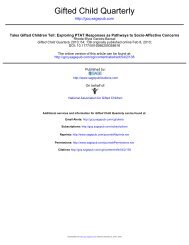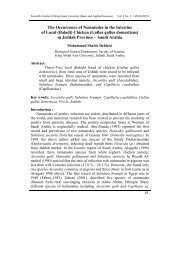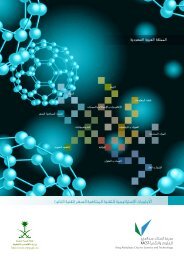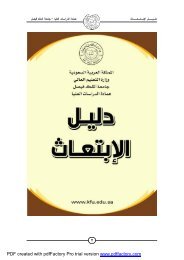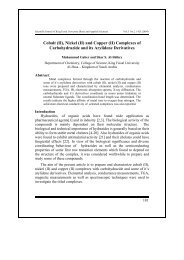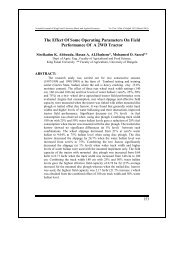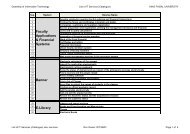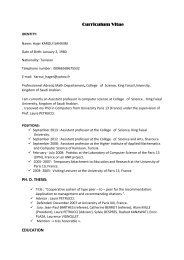Efficiency of Kaolin and Activated Charcoal to Reduce the Toxicity of ...
Efficiency of Kaolin and Activated Charcoal to Reduce the Toxicity of ...
Efficiency of Kaolin and Activated Charcoal to Reduce the Toxicity of ...
You also want an ePaper? Increase the reach of your titles
YUMPU automatically turns print PDFs into web optimized ePapers that Google loves.
<strong>Efficiency</strong> <strong>of</strong> kaolin <strong>and</strong> activated charcoal…Hesham M. Teleb et. al.once is formed. Practical <strong>and</strong> effective methods <strong>to</strong> de<strong>to</strong>xify AF containingfeedstuffs are in great dem<strong>and</strong>. A variety <strong>of</strong> physical, chemical <strong>and</strong>biological approches have beenrted (Goldblatt <strong>and</strong> Dollear, 1979; Andrson,1983; Smith, 1984; Philips et al., 1988; Gazia et al., 1991; Park, 1993 <strong>and</strong>Santurio et al., 1999). Ano<strong>the</strong>r approach <strong>to</strong> <strong>the</strong> problem has been <strong>to</strong> use nonnutritive<strong>and</strong> inert adsorbents in <strong>the</strong> diet <strong>to</strong> bind AF <strong>and</strong> reduce <strong>the</strong>irabsorption from gastrointestinal tract. These compounds must not beabsorbed from gastrointestinal tract <strong>and</strong> must have <strong>the</strong> ability <strong>to</strong> bindphysically with <strong>the</strong> chemical substances <strong>and</strong> precludes <strong>the</strong>ir absorption. Themajor advantages <strong>of</strong> <strong>the</strong>se adsorbents include expense, safety, <strong>and</strong> easyadministration through addition <strong>to</strong> <strong>the</strong> animal feed (Ledoux et al., 1999).Zeolites (hydrated sodium calcium aluminosilicat (Kubena et al., 1993 &1998; Kececi et al., 1998; <strong>and</strong> Ledoux et al., 1999), activated charcoal(Dalvi <strong>and</strong> Ademoyero, 1984; Dalvi <strong>and</strong> McGowan, 1984; Kubena et al.,1993 & 1998) <strong>and</strong> clinoptilolite (Oguz et al., 2000) have been used for thispurpose. Food <strong>and</strong> Drugs Administration (FAD) <strong>of</strong> <strong>the</strong> United States <strong>of</strong>America estimated 20 ppb as tentative maximal allowance <strong>to</strong>lerance <strong>of</strong> AFin broiler feed. The objectives <strong>of</strong> this study were <strong>to</strong> evaluate <strong>the</strong> efficiency<strong>of</strong> two binding agents (kaolin <strong>and</strong> activated charcoal) for protection againstlow-level Afla<strong>to</strong>xicosis, in broiler chicken. Growth performance,his<strong>to</strong>pathological change, <strong>and</strong> AF residue in <strong>the</strong> edible meat were utilized asevalua<strong>to</strong>ry parameters.Materials <strong>and</strong> MethodsChicken <strong>and</strong> dietsThree hundred <strong>and</strong> twenty <strong>of</strong> one-day old broiler chicks (Hubbard) <strong>of</strong>both sex obtained from a commercial hatchary were used in this study.Ckicks were individually weighed <strong>and</strong> divided r<strong>and</strong>omlly in<strong>to</strong> four equaldesignated groups 1, 2, 3 <strong>and</strong> 4. Chicks were allowed access <strong>to</strong> feed <strong>and</strong>water ad libitum . Basal diet was formulated according <strong>to</strong> <strong>the</strong> NationalResearch Council (NRC, 1994) requirement. The basal diet was tested forpossible residual AF before feeding (Samuel, 1978). The experiment lasted45 days.Afla<strong>to</strong>xin preparation:Aspergillus flavus was grown on corn meal as described by Harvey et al.(1989),<strong>and</strong> Kubena et al. (1990 & 1993) . The contaminated AF corn was146



